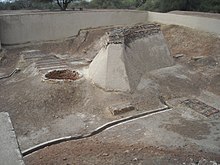Archaeological sites in Pakistan

Stone Age
Lower Paleolithic (Pre-Soanian)

Pre-Soanian culture in Pakistan corresponds to Oldowan culture dating back to the Mindel glaciation. Some findings in Punjab belong to this period.[4]
Lower to Middle Paleolithic (Soanian)
Early Soanian sites correspond to the
- Adiala
- Chauntra
- Ghariala
- Riwat
- Balawal
- Chak Sighu
- Chakri
- Rawalpindi
- Morgah
- Dina
- Jalalpur Sharif
Neolithic
Mehrgarh (c. 7000 BCE - 2000 BCE), from Neolithic age, in Balochistan is one of the earliest sites with evidence of agriculture and village structure.[2]
- Pre Harappa
Pre-Harappan farming communities date back to Neolithic time which ultimately evolved into urban Harappan civilization.[7][8] Explorations and archaeological findings establish the dateline of Pre-Harappan culture from 2700 BC to 2100 BC followed by Harappan period from 2100 BC onwards.[9] Some of the regions showing pre-Harappan culture include;
- Pirak where the culture later advanced into Indus Valley Civilization.[8]
- Bolan[8]
- Kachi[8]
- Sheri Khan Tarakai is a neolithic village and second oldest farming settlement in South Asia.[10]
- Lewan[10]
- Akra[10]
- Kili Gul Muhammad
- Amri-Nal[8]
- Kulli[8]
- Kot Diji[7][9]
Bronze Age

- Early Harappan
- Harrappa
- Rehman Dheri - 4000 BCE
- Amri- 3600 to 3300 BCE
- Nausharo
- Rana Ghundai
- Sur Jangal
- Indus Valley civilization
- Mohenjo-daro in Sindh
- Dabar Kot
- Periano Ghundai
- Chanhudaro in Sindh
- Lakhueen-jo-daro
- Sutkagan Dor
Iron Age

- Takht-i-Bahi in Khyber Pakhtunkhwa
- Seri Bahlol in Khyber Pakhtunkhwa
- Akra in Khyber Pakhtunkhwa
- Taxila in Punjab
- Mankiala in Punjab
- Thatta in Sindh
- Mehluha in Sindh
Middle age
Classical age
- Gandhara and its capital Pushkalavati
- Pattala
Late medieval age
Islamic era
Islamic influence in the region started as early as 7th Century.
See also
- List of World Heritage Sites in Pakistan
- Hindu and Buddhist architectural heritage of Pakistan
- List of monuments in Pakistan
- Tourism in Pakistan
References
- ISBN 9788120814073.
- ^ ISBN 9781438119137.
- ISBN 9780759101722. Retrieved 24 March 2013.
- ^ ISBN 9783110810035. Retrieved 24 March 2013.
- ^ Parth R. Chauhan. "An Overview of the Siwalik Acheulian & Reconsidering Its Chronological Relationship with the Soanian". Archived from the original on 4 January 2012. Retrieved 24 March 2013.
- ^ Kumar; Manoj (2017). "A study on proto historic settlements in upper Chautang valley Haryana" (PDF).
{{cite journal}}: Cite journal requires|journal=(help) - ^ ISBN 9788122411980. Retrieved 25 March 2013.
- ^ ISBN 9788180695216. Retrieved 25 March 2013.
- ^ ISBN 9788180692406. Retrieved 25 March 2013.
- ^ a b c "The Bannu Archaeological Project". Department of Archaeology & Anthropology, University of Cambridge. Archived from the original on 1 July 2013. Retrieved 25 March 2013.
